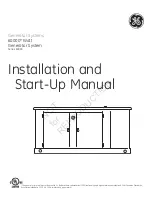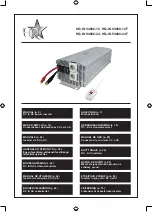
Shut-down due to reversal of polarity at the DC input terminals.
The positive of the
battery should be connected to the positive DC input terminal of the inverter and the negative
of the battery should be connected to the negative DC input terminal of the inverter. A
reversal of polarity (the positive of the battery
wrongly connected
to the negative DC input
terminal of the inverter and the negative of the battery
wrongly
connected
to the positive DC
input terminal of the inverter) will blow the DC side fuses inside the inverter
.
If the DC side
fuses are blown, the inverter will be dead. There will be no indication of any voltage on the
bar graph voltage indicator and also, there will be no AC output.
The internal fuses should be
replaced with the correct size of fuses shown under specifications. If the unit does not work
after replacing the fuses, it has been permanently damaged. Please call Technical Support for
assistance.
Shut-down due to over-temperature.
In case of failure of the cooling fan or in the case of
inadequate heat removal due to higher ambient temperatures / insufficient air exchange, the
temperature inside the unit will increase. The temperature of a critical hot spot inside the
inverter is monitored and at a particular upper limit, the AC output of the inverter is shut
down temporarily. The red
Over Temp
LED (b) is lighted and a buzzer is sounded. The unit
will automatically reset after the unit has cooled down.
Shut-down due to instantaneous overload.
The inverter can provide a higher than normal
instantaneous (< 2 seconds) power limited to the surge power rating of the inverter. If the
instantaneous power required by the load exceeds the surge power rating of the inverter, the
AC output of the inverter is shut-down temporarily for the duration of the instantaneous
overload. It resets automatically when the load reduces below the level of the surge rating.
Shut-down due to continuous overload beyond the continuous power rating.
The inverter
is designed to deliver continuous power limited to its continuous power rating. If there is a
continuous overload beyond the continuous power rating of the inverter, the inverter will shut
down completely. The red
Overload
LED
(c) will be lighted.
The
unit will be latched in this
condition
.
To reset, switch the on / off switch (a) to the off position and on again. Before switching
on again, please ensure that the cause of continuous overload has been removed
NOTE: If the overload LED (C) remains lighted after re-setting the unit, remove all the loads
from the inverter and re-set again. If the red overload LED (C) still remains lighted without any
load, the inverter has developed an internal defect. Please call Technical Support.
Page 30






































